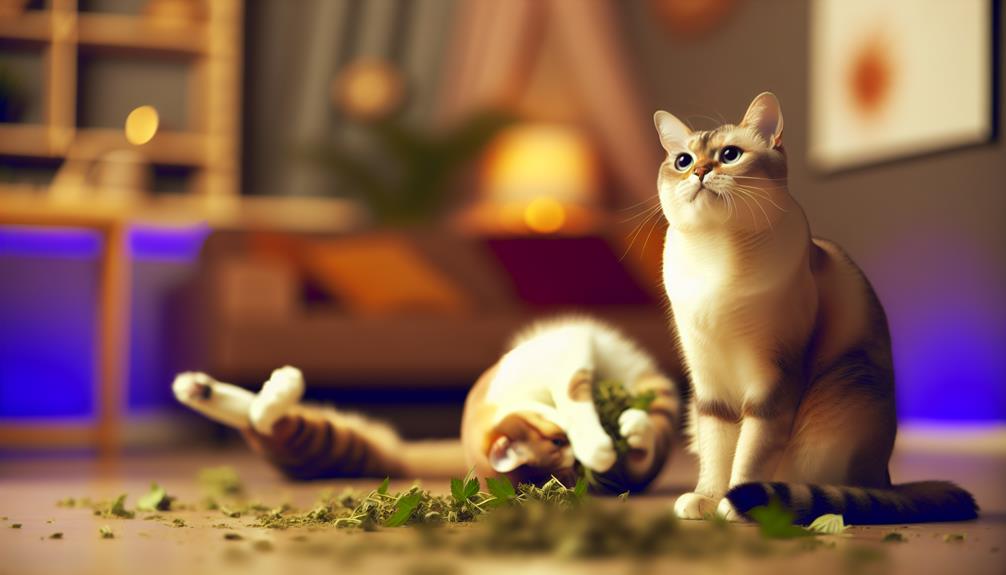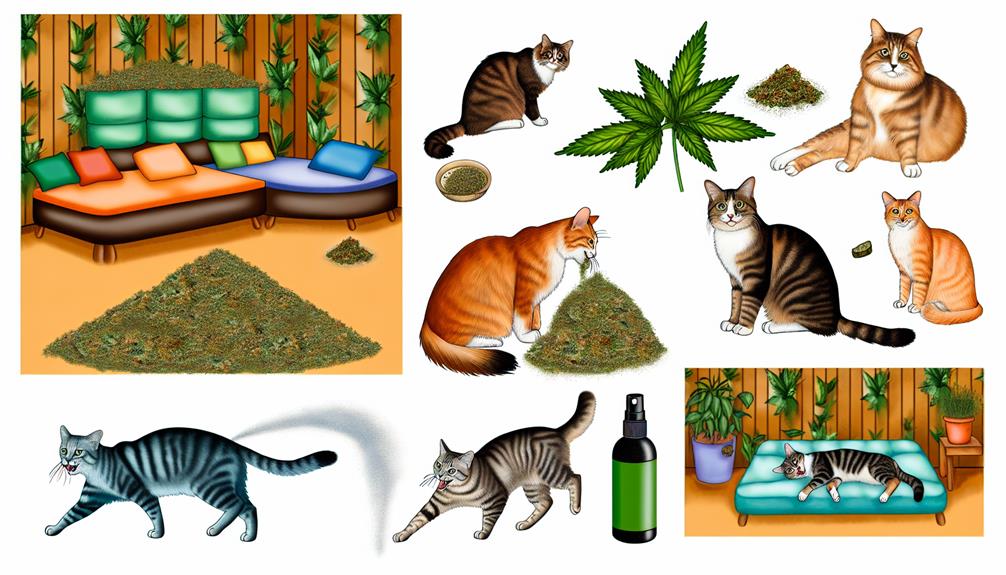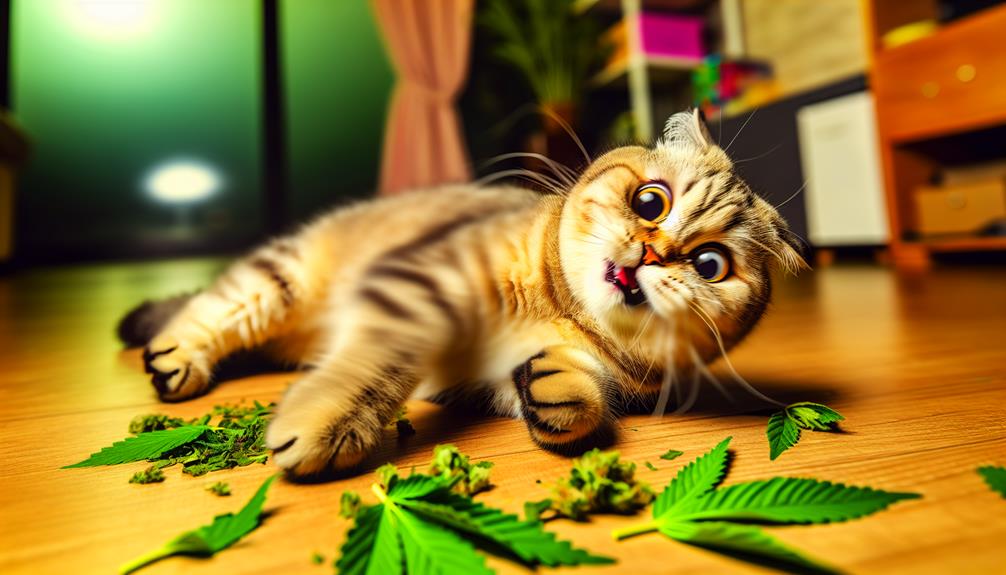Imagine your cat, Whiskers, encountering catnip for the first time: she sniffs it, rolls around, and starts purring louder than you've ever heard. This curious reaction is due to nepetalactone, the active compound in catnip that triggers playful and euphoric behaviors in many cats. However, not all felines respond the same way, with some showing no interest at all. Have you ever wondered why this happens, or how often you should let your cat indulge in catnip? Understanding these nuances can help you make the most of this intriguing herb for your pet.
The Science of Catnip
When delving into the science of catnip, it is essential to understand the active compound responsible for its effects: nepetalactone. Nepetalactone, a bicyclic terpenoid, is the primary constituent of catnip (Nepeta cataria) important oil. This compound interacts uniquely with the sensory pathways of felines, eliciting a range of physiological responses.
Catnip compounds, including nepetalactone, are detected by the vomeronasal organ, also known as Jacobson's organ, located in the roof of a cat's mouth. When a cat sniffs or licks catnip, the nepetalactone molecules bind to the receptors in this organ, which are part of the accessory olfactory system. This binding triggers a cascade of neural signals that travel to the brain, particularly affecting the amygdala and hypothalamus, regions involved in emotional and behavioral responses.
Feline receptors in the vomeronasal organ are highly specialized to detect pheromones and similar volatile substances. Nepetalactone mimics the structure of feline pheromones, which explains its potent effect on cats. The interaction between nepetalactone and these receptors is both species-specific and dose-dependent. Not all cats respond to catnip, and sensitivity typically emerges around sexual maturity, suggesting a genetic basis for nepetalactone sensitivity.
Moreover, the potency of catnip is influenced by its chemical composition, which can vary based on the plant's growing conditions and processing methods. Understanding the precise interaction between catnip compounds and feline receptors can help in developing more targeted and effective catnip products. This knowledge is essential for both pet owners and veterinary professionals aiming to manage feline behavior and well-being through environmental enrichment.
Behavioral Effects on Cats
In relation to behavioral effects on cats, exposure to catnip can elicit a wide range of observable responses, largely dictated by individual sensitivity. When a cat encounters catnip, it primarily reacts to nepetalactone, the active compound in the plant. The behavioral manifestations vary, but they often include increased social interactions and playful antics. Understanding these behaviors can help you manage and enrich your cat's environment effectively.
The effects of catnip typically fall into several categories. Here's a breakdown:
| Behavior Type | Description | Duration |
|---|---|---|
| Playful Antics | Rolling, flipping, and chasing objects | 5-15 minutes |
| Social Interactions | Increased affection, rubbing against you | 5-10 minutes |
| Vocalization | Increased meowing or purring | 5-10 minutes |
| Sedation | Relaxed state, lying down, zoning out | 10-30 minutes |
| Hyperactivity | Rapid movements, jumping, and running | 5-10 minutes |
Playful antics are among the most common responses. Your cat might roll on the ground, flip over, or chase imaginary objects. This behavior is typically short-lived but highly engaging for the animal. Enhanced social interactions are also observed, with cats becoming more affectionate, often rubbing against you or other objects. This could be an opportunity for you to bond with your pet.
Some cats exhibit vocalization, characterized by increased meowing or purring. This can indicate a heightened state of arousal or pleasure. Other cats might enter a state of sedation, lying down and appearing relaxed. Hyperactivity is less common but can manifest as rapid, erratic movements, including jumping and running.
Why Some Cats Don't React

Genetics play a pivotal role in determining a cat's sensitivity to catnip. Not all cats exhibit the characteristic euphoria associated with catnip exposure, and this discrepancy can primarily be attributed to genetic factors. Approximately 30-50% of the feline population lacks the genetic predisposition necessary to respond to nepetalactone, the active compound in catnip. This genetic trait is hereditary, and kittens born to parents who are non-responders are more likely to also be non-responders.
Furthermore, age influence is another critical variable in a cat's reaction to catnip. Neonates and very young kittens typically show no reaction to catnip, even if they possess the genetic predisposition. Sensitivity usually develops as a cat matures, often becoming apparent around three to six months of age. Conversely, some senior cats may exhibit a diminished response to catnip, possibly due to age-related sensory declines or changes in neurological function.
The olfactory system of cats, particularly the vomeronasal organ, plays a significant role in detecting nepetalactone. Cats that do not react to catnip might have differences in their olfactory receptors or neural pathways, rendering them insensitive to the compound. Additionally, environmental factors and previous exposure to catnip may also modulate the response, although these are secondary to inherent genetic and age-related factors.
Understanding these genetic factors and age influence can help you better anticipate whether your cat will enjoy catnip. It's essential to remember that a lack of response is entirely normal and doesn't indicate any health issue. Each cat is unique, and their individual genetic makeup will ultimately dictate their reaction to catnip.
Safe Usage of Catnip
Guaranteeing the safe usage of catnip is essential for maintaining your cat's wellbeing. Catnip, scientifically known as Nepeta cataria, contains the active compound nepetalactone, which can elicit euphoria in felines. However, it's important to administer catnip responsibly to avoid adverse effects.
A prudent catnip dosage should be small, typically a pinch or about 1/2 teaspoon for dried catnip. Overexposure can lead to gastrointestinal upset or behavioral changes, so moderation is key. You should limit catnip exposure to once every two to three weeks to prevent desensitization or dependency.
Consider catnip alternatives if your feline doesn't react to catnip or if you prefer different enrichment options. Silvervine (Actinidia polygama) and Tatarian honeysuckle (Lonicera tatarica) are effective substitutes that can also provide similar stimulating effects. Valerian root (Valeriana officinalis) serves as another alternative, known for its calming properties.
Here's a summary table to guide the safe usage of catnip:
| Aspect | Recommendation | Notes |
|---|---|---|
| Catnip Dosage | 1/2 teaspoon | Guarantee to monitor the cat's response |
| Frequency of Use | Every 2-3 weeks | Prevents desensitization |
| Adverse Effects | Gastrointestinal upset, lethargy | Seek veterinary advice if symptoms persist |
| Catnip Alternatives | Silvervine, Tatarian honeysuckle, Valerian root | Provide different enrichment options |
Different Forms of Catnip

Catnip comes in various forms, each offering unique benefits and applications for feline enrichment. Understanding these different manifestations can help you choose the most suitable option for your cat's needs.
Catnip toys are perhaps the most popular form. These toys are often stuffed with dried catnip, providing a long-lasting source of stimulation. The physical activity your cat engages in while playing with these toys can also be beneficial for their overall health, promoting exercise and reducing stress.
Dried catnip itself is another common form. You can sprinkle it on scratching posts, bedding, or even mix it with your cat's food. This form is versatile and allows for easy customization of the catnip experience. However, the potency of dried catnip can diminish over time, so it's important to store it in an airtight container.
Catnip sprays offer a convenient alternative. These are typically made by distilling the essential oils from the catnip plant and mixing them with water or alcohol. Catnip sprays can be applied to toys, bedding, or any surface you want to encourage your cat to explore. They are particularly useful for older cats that may not respond as strongly to dried catnip.
Lastly, catnip plants provide a fresh and ongoing source of the herb. You can grow these plants indoors or outdoors, allowing your cat to nibble on the leaves directly. Fresh catnip tends to have a more potent effect due to the higher concentration of nepetalactone, the active compound that induces the euphoric response in cats.
Conclusion
Using catnip responsibly is like giving your cat a roller coaster ride of sensory delight. Understanding the science, behavioral impacts, and genetic variances guarantees your feline friend enjoys the experience without adverse effects. Remember, moderation is key—limit exposure to every 2-3 weeks to maintain sensitivity and prevent desensitization. By following these guidelines, you're guaranteeing not just an occasional thrill, but also the long-term well-being of your cherished companion.
